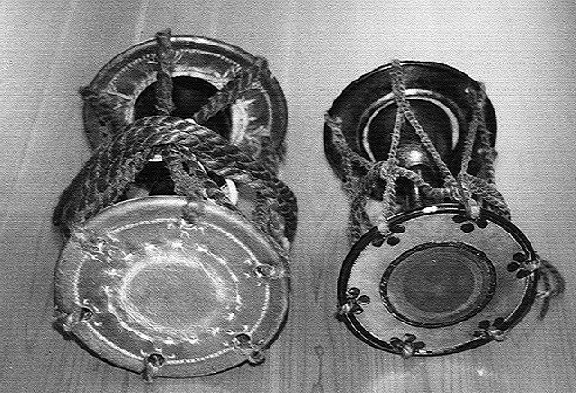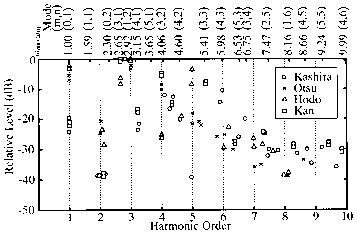Shigeo Ando - ando@lab2.yamaha.co.jp
Electronics D & D Center AS Development Group
YAMAHA Corporation
203 Matsunokijima
Toyooka-mura, Iwata-gun
Shizuoka-ken 438-01, Japan
Popular version of paper 4aMUb3
Presented Thursday, December 5 1996
Third Joint ASA/ASJ Meeting, Honolulu, USA
Embargoed until 5 December 1996
Tsuzumis are types of drums played in Japanese traditional performing arts, such as 'Nou' and 'Nagauta'. There are two kinds of Tsuzumi, Ootsuzumi and Kotsuzumi, that have almost the same structure, but whose playing styles, tone colors and vibration modes are different. Fig.1 shows a photograph of Ootsuzumi (left) and Kotsuzumi (right).
In this paper[1], the vibration properties of Tsuzumi membranes are first reviewed, and then Ootsuzumi and Kotsuzumi tones are analyzed and some parameters of Tsuzumi tone waveforms are extracted. Finally a subjective test is performed on tones synthesized using analyzed data and the acoustical features of Tsuzumi are discussed.

Fig.1 Photograph of Ootsuzumi (left) and Kotsuzumi (right).
The leathers have the most uniform density possible, which is better on Ootsuzumi, and are kept dry while playing, making them ideal circular membranes which have a characteristic vibrational equation Jm(x)=0. Therefore, the vibrational frequencies of Ootsuzumi can be described using ratios of roots of the Bessel function.
The face leather of Kotsuzumi has a circular groove called 'Kannyu' and forms a kind of annular membrane whose vibrational frequencies approach extremely precise harmonic relationships when the ratio of two annular membrane radii is less than 1.2. Hence, the face leather of Kotsuzumi has a factor with which the vibrational frequencies have a close harmonic relationship.
A few sheets of Japanese paper wet with saliva, called 'Choshigami', are placed in an area of about 1 cm^2 at the center of the Kotsuzumi back leather in order to adjust the tone color. This is considered a circular membrane with a mass load at the center whose vibrational frequencies converge on integer multiples of the fundamental. Therefore, the back leather of Kotsuzumi has a feature whereby the vibrational frequencies come near harmonic relationships by adding 'Choshigami', i.e., adding a proper load to the membrane.
There are several playing styles for Ootsuzumi and Kotsuzumi. The Tsuzumi tones were analyzed using Discrete Fourier Transforms for every playing style according to the following parameters: A. waveform, B. spectrum, C. amplitude envelope of partials and D. frequency change of partials[2].
Fig.2 and Fig.3 show the spectra of Ootsuzumi and Kotsuzumi tones where ratios of angular frequencies of partials to the fundamental on the horizontal axis and spectrum levels on the vertical axis were plotted out. In the diagrams, two spectra of tones with each playing style were drawn. The upper numerical values show the vibrational mode of a circular membrane and ratios of the vibrational frequency to the fundamental; the lower axis shows the values of harmonic order. From Fig.2, the ratios of frequencies of lower order partials of Ootsuzumi tones generally agree with those of characteristic vibrational frequencies of a circular membrane. On the other hand, Fig.3 shows rough harmonic relationships, ever though there are partials which are slightly out of harmonic structure.

Fig.2 Spectrum of Ootsuzumi tones with three playing styles with ratios of the frequencies
to the fundamental on the horizontal axis.

Fig.3 Spectrum of Kotsuzumi tones with four playing styles.
Synthesized tones of Ootsuzumi and Kotsuzumi are made using analyzed data. the synthesized waveform of Ootsuzumi is roughly similar to the original one, though they are slightly different at the beginning of the tone. The synthesized waveform of Kotsuzumi is roughly similar to the original one after 20 msec, though they are different during the first 20 msec after the attack transient.
A subjective test is performed on synthesized tones and original ones adding an electronic musical instrument tone. In this experiment, Tsuzumi tones are divided into group A, mainly composed of original and synthesized Ootsuzumi tones; group B, mainly composed of original and synthesized Kotsuzumi tones. And also the original tones of each Tsuzumi with the Kashira and Kan styles are added to the other groups.
The results show that each tone color of synthesized tones similar to the original ones can be reproduced by using partial additive synthesis for Ootsuzumi tones, additive synthesis for Kotsuzumi tones on Otsu and Hodo styles and additive synthesis used together with partial additive synthesis for parts of spectrum for Kotsuzumi tones on Kashira and Kan styles.
In summary, it is described that the outline of acoustical properties of Tsuzumi was made clear through numerical analysis of vibrational modes of Tsuzumi, analysis and synthesis of Tsuzumi tones and subjective testing of them.
References
[1] S.Ando and K.Yamaguchi, "Acoustical studies of Japanese traditional drums 'Tsuzumi' ---Analysis, synthesis and subjective evaluation---," J.Acoust.Soc.Jpn. 41(6), 386-394(1985).
[2] S.Ando and K.Yamaguchi, "Statistical study of spectral parameters in musical instrument tones," J.Acoust.Soc.Am. 94(1), 37-45(1993).
Sound Samples
 1. Ootsuzumi tones on Kashira style -
2. Kotsuzumi tones on Otsu style (265 kB WAV file)
1. Ootsuzumi tones on Kashira style -
2. Kotsuzumi tones on Otsu style (265 kB WAV file)